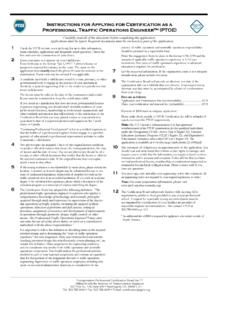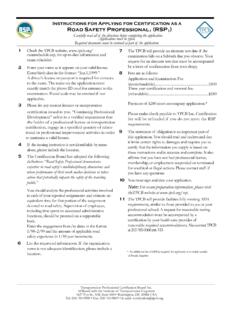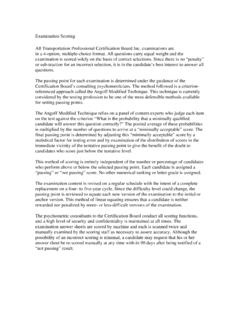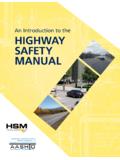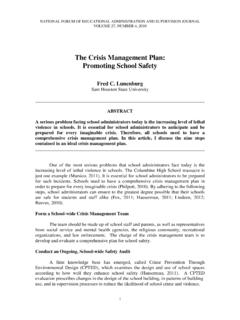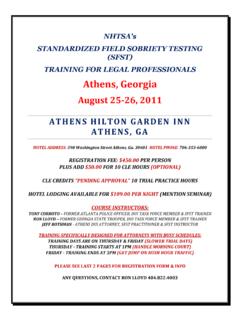Transcription of Frequently Asked Questions - tpcb.org
1 1 Frequently Asked Questions Why is this certification being developed? With more than 40,000 lives lost annually on highways in the United States and Canada and the growing attention on improving public safety through initiatives such as Toward Zero Deaths, Vision Zero, and the Road to Zero, the RSP represents an important step forward for the safety profession. The RSP certification provides for professionals involved in a wide array of safety -related disciplines to establish their competency in providing for the safety of the traveling public. What are the objectives of the Road safety Professional certification? To recognize road safety as a profession To establish a recognized level of practice and knowledge To incentivize safety education To support public safety initiatives such as Toward Zero Deaths, Vision Zero, and Road to Zero What are the qualifications for Level 1 exam?
2 Bachelor s degree from an accredited university and a minimum of two (2) years professional experience in transportation, highway safety or public health; or A minimum of four (4) years professional experience in the transportation, highway safety , or public health fields. What are the qualifications for Level 2 exam? Successful completion of Level 1 Exam; and Bachelor s degree from an accredited university and a minimum of five (5) years professional experience in transportation, highway safety or public health; or A minimum of ten (10) years professional experience in the transportation, highway safety or public health fields. 2 What are the differences between the two levels of the exams? Level 1 Level 2 Description Demonstrates expertise in road safety s multidisciplinary dimensions Higher level certification that demonstrates deeper level of understanding and proficiency in road safety science Audience For any professional who in the performance of their work makes decisions or takes actions that potentially impact the safety of the traveling public Any professional whose primary job functions are directed at improving the safety performance of the surface transportation system Exam Options One option Two options.
3 Behavorial Infrastructure Time Frame First exam October 2018 First Exam October 2019 Qualifications Combination bachelor s degree and 2-4 years experience transportation, highway safety or public health Successful completion of Level 1 exam Combination bachelor s degree and 5-10 years experience transportation, highway safety or public health Exam Content 3 hours 75 Questions Qualitative Multiple Choice 3 hours 75 Questions Qualitative and quantitative Multiple Choice 3 What resources are available to help individuals prepare? Listed below are suggested resources for the preparation of the Level 1 exam. AASHTO Highway safety Manual, 2010 available online here Road safety Fundamentals available online here NHTSA Countermeasures That Work: A Highway safety Countermeasures Guide for State Highway safety Offices, 2015 available online here ITE Traffic Engineering Handbook, 7th Edition, 2016 available online here Crash Modification Factors Clearinghouse available online here AAA Improving Traffic safety in the United States, The Journey Forward, 2007 available online here NCHRP Report 501 Integrated safety Management Process available online here Human Factors In Traffic safety , 3rd Edition, Edited by Alison Smiley, Lawyers and Judges Publishing Company Inc.
4 , 2015 - available online here NCHRP Report 500 Guidance for Implementation of the AASHTO Strategic Highway safety Plan - available online here A Guide for Addressing Run-Off-Road Collisions Volume 6 A Guide for Reducing Collisions Involving Pedestrians Volume 10 A Guide for Reducing Collisions at Signalized Intersection Volume 12 A Guide for Reducing Collisions Involving Bicycles Volume 18 PIARC Road safety Manual available online here The Institute of Transportation Engineers is offering the RSP Level 1 Refresher Course, an overview of topics, key references, and independent study materials by topic for individuals in the transportation, safety , and public health professions who intend to take the Road safety Professional (RSP) Level 1 certification exam.
5 This course includes a suite of five (5) 90-minute live webinars on foundational elements of road safety , the collection and application of crash data and associated safety measures, human factors and their impact on roadway safety , safety management and the use of countermeasures, and the development and implementation of strategic safety plans. These webinars are being recorded and will be available on demand shortly following the conclusion of the last webinar. For more information on dates and times of each module is available here. Are the exams available in a language other than English? At current, the exams are only available in English. When will the first RSP Level 1 exam be held? The first RSP exam is scheduled for the month of October 2018. The deadline for this exam date has passed.
6 The next exam period is February 2019. Download an application here. The deadline to apply for the February 2019 exam period is December 4, 2018. For a list of available exam cities, click here. Are there additional exam dates for the RSP Level 1 exam? Yes, exams will be held annually during the months of February, June, and October. For information, visit 4 What is the structure of the exam? Each of the exams is a 75 multiple-choice question, three (3) hour exam. The Level 1 exam is qualitative in nature. While knowledge of quantitative methods may be examined, no computations will be required to complete the exam. The Level 2 exam includes Questions that are both qualitative and quantitative in nature. Do you sit for the exam in-person or can one complete it online? The exam is in-person at one of the Castle testing sites.
7 The test is completed electronically. For a list of testing sites, visit Will this exam be closed book? Yes, this is a closed book exam. How can I find out about where the exam will be held? Castle Worldwide has testing sites throughout the and Canada. Visit for a list of locations. How much does it cost to take the exam? The application/examination fee is US$100. The three-year certification fee is US$180 (US$60/year). Are there discounts available? Yes, discounts are provided for existing PTOE/PTP certification holders. There are not discounts for licensed PEs. What does the exam cover? Below is the content outline for Level 1 exam. The content outline for the Level 2 exam is forthcoming. Domain I: Foundations of Road safety Task 1: Define road safety by using an approved reference source ( , Highway safety Manual, highway safety plans).
8 Task 2: Describe evidence-based road safety , including the distinction of nominal vs. substantive safety , by using road safety literature ( , ITE Handbook). Task 3: Describe the complexity of road safety and list the elements that are involved in crash causation and influence the severity of the outcome. Task 4: List road safety -relevant characteristics of different road users ( , drivers, pedestrians, cyclists) and how they apply to effective selection of countermeasures. Task 5: Identify partners in road safety by listing disciplines and agency types that have a role to play in preventing crashes and reducing their severity. 5 Task 6: Describe different approaches to road safety management ( , traditional 4E, Haddon s matrix, safe systems approach, Vision Zero). Task 7: Describe how to balance safety with other transportation goals ( , environment, congestion, mobility) by evaluating safety benefits and costs for comprehensive comparison and decision-making.
9 Task 8: Describe the elements of a culture that fosters road safety within an organization or discipline and how to achieve it. Task 9: Discuss developments in policy and technology that will influence future decisions and actions in road safety . Domain II: Measuring safety Task 1: Identify types, applications, and users of safety data, and discuss the challenges, limitations, and ways to mitigate them by using nontraditional safety data. Task 2: Discuss how the quality of safety data can lead to more effective programs, projects, and initiatives and investments. Task 3: Explain how key factors ( , speed, volume, time of day) could affect the frequency and severity of crashes. Task 4: Explain the primary components of quantitative safety analysis. Domain III: Human Behavior and Road safety Task 1: Identify key characteristics and limitations of human behavior that influence how road users interact with the roadway environment.
10 Task 2: Describe multidisciplinary safety strategies to modify human behavior. Task 3: Describe the key characteristics of effective educational strategies ( , informational/awareness campaigns) and discuss their benefits and limitations in modifying human behavior. Task 4: Describe the key characteristics of effective enforcement campaigns and discuss their benefits and limitations in modifying human behavior. Task 5: Describe and give examples of how roadway infrastructure features and elements ( , traffic control devices, road alignment, cross section) affect human behavior. Task 6: Describe why human factors should be considered in the process of planning, design, and operations to increase the safety of all road users. Task 7: Describe how applying positive guidance principles to road elements can be used to affect road user behavior and improve safety performance.

